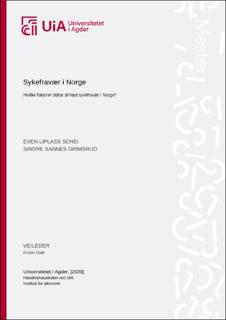| dc.contributor.author | Schei, Even Liplass | |
| dc.contributor.author | Grimsrud, Sindre Sannes | |
| dc.date.accessioned | 2020-09-25T07:39:24Z | |
| dc.date.available | 2020-09-25T07:39:24Z | |
| dc.date.issued | 2020 | |
| dc.identifier.citation | Schei, E.L. & Grimsrud, S.S. (2020) Sykefravær i Norge Hvilke faktorer bidrar til høyt sykefravær i Norge? (Master´s thesis). University of Agder, Kristiansand | en_US |
| dc.identifier.uri | https://hdl.handle.net/11250/2679588 | |
| dc.description | Master`s thesis in Business Administration (BE501) | en_US |
| dc.description.abstract | Sickness absence is a major expense for the Norwegian welfare state. This master’s thesis will discuss various factors that affect Norwegian sickness absence. OECD issued a report in 2018, which showed that Norway had the highest rate of sickness absence among the member countries. Among these countries, Norway also has the most generous welfare system. Therefore, several Norwegian leaders have pointed out that today’s sick pay scheme is not sustainable if the high absenteeism and unemployment rate continues.The theory section will describe the characteristics of the welfare state, and the socio-economic consequences of the sick pay scheme. Since the Scandinavian countries are based on the same welfare principles, a comparative case study is used, which makes it possible to compare several countries against each other. In this way, the study can reveal inequalities and explain the relatively high sickness absence rate in Norway. Some of the causes that are compared in this study are the degree of compensation, health conditions, workplace stability and gender differences.Through the analysis, the master’s thesis reveals that it is not a factor that is decisive for sickness absence, but the amount of several. The differences in composition between the Scandinavian countries are relatively small, so these will not make any major differences. That said, job protection for temporary employees stands out during sickness absence. This leads to greater stability in the workplace for Norwegian workers. Another factor that has an impact on sick leave is the degree of compensation. Employees in Norway who have a salary below6G (599 148 NOK) will achieve a higher level of benefit from sickness absence. Such a scheme will therefore not give the absent person an incentive to return to work faster. Compared to Norway, the sick pay scheme in Denmark and Sweden has a stronger disciplinary effect.Women have around 70 percent higher sickness absence than men in Norway. By controlling for conditions such as work, family and pregnancy, about half of these differences will still be unexplained. Through SPSS, a health regression analysis was performed with the European OECD-Countries. The analysis showed that the state of health does not explain the sickness absence to any great extent. The study will discuss sick leave considering economic theory, recent professional literature and conduct a regression analysis on OECD figures for 2018. | en_US |
| dc.language.iso | nob | en_US |
| dc.publisher | University of Agder | en_US |
| dc.rights | Attribution-NonCommercial-NoDerivatives 4.0 Internasjonal | * |
| dc.rights.uri | http://creativecommons.org/licenses/by-nc-nd/4.0/deed.no | * |
| dc.subject | BE501 | en_US |
| dc.title | Sykefravær i Norge Hvilke faktorer bidrar til høyt sykefravær i Norge? | en_US |
| dc.type | Master thesis | en_US |
| dc.rights.holder | © 2020 Even Liplass Schei & Sindre Sannes Grimsrud | en_US |
| dc.subject.nsi | VDP::Samfunnsvitenskap: 200::Statsvitenskap og organisasjonsteori: 240::Offentlig og privat administrasjon: 242 | en_US |
| dc.source.pagenumber | 97 | en_US |

